
Guatemala
People's Guide Tours
Discovering the Roots of Enchantment
in Guatemala and Honduras
 Part 4
Part 4
By Sharon Luckerman
Our last drive with Max from Santa Rosa to Copan takes us through a sub-tropical Switzerland, some of the most mountainous vistas of our trip. As we near our destination, the road begins to widen into a valley and the open space beckons like a magnet, pulling us toward the enchanted ruins.
The ancient Maya city of Copan stretches over 27 square miles. It thrived between 200 BC and 800 AD, when it fell to the neighboring city of Quiriqua, and was subsequently mysteriously abandoned. The city's remains include almost 5000 mounds, great temples, tall intricately carved stelae (stone monuments), a grand plaza, ball court, and an acropolis in the process of meticulous reconstruction. Areas like nearby mountain caves reachable by horseback remain relatively unexplored.
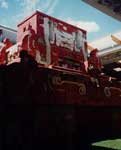 In addition, we are lucky that the anthropological museum finally opened in l996 and to rave reviews; the entrance itself an experience. We step through a doorway that's a large opened snake's mouth and walk a serpentine path that mirrors an archeological tunnel.
In addition, we are lucky that the anthropological museum finally opened in l996 and to rave reviews; the entrance itself an experience. We step through a doorway that's a large opened snake's mouth and walk a serpentine path that mirrors an archeological tunnel.
I have to push myself to go on, almost frightened by the cool darkness of this passageway to the unknown. In a way, it connects the new world, where we come from, to the old, where we are going; the world of the living to that of the dead, of our ancestors. With a glint of light at the final curve of the corridor, I am relieved, the cycle of death and rebirth complete, especially by what I see next. The tunnel opens onto an exquisite four-story high bright red temple, completely rebuilt. A replica of the Maya temple Rosalila, it was the first complete structure discovered at Copan, found inside another temple in the heart of the Acropolis.
 Nothing compares, however, with walking through the abandoned city itself, past the plain of ornately sculpted stelae and first spying the steep, hieroglyphic stairway several stories high which, our guide informs us, was the longest written text at the time in the New World.
Nothing compares, however, with walking through the abandoned city itself, past the plain of ornately sculpted stelae and first spying the steep, hieroglyphic stairway several stories high which, our guide informs us, was the longest written text at the time in the New World.
After climbing up and around the ball court and across the acropolis, I sit for a moment on one of the long narrow steps away from the others, listening to the wind whistle past. It's as if it carries stories of the people who built these structures centuries ago and who sat on these very stones having no idea the mystery their works would pose thousands of years later to a people they had no idea existed.
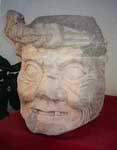 Our awe deepens as the concept behind each form and structure begins to reveal the great civilization that once thrived here. Everything in their daily life, from the clothes they wove to the fires they built to the structure of their archways, had meaning. It is even more haunting therefore that this great city, not unlike New York or Paris or Athens in its time, was completely abandoned.
Our awe deepens as the concept behind each form and structure begins to reveal the great civilization that once thrived here. Everything in their daily life, from the clothes they wove to the fires they built to the structure of their archways, had meaning. It is even more haunting therefore that this great city, not unlike New York or Paris or Athens in its time, was completely abandoned.
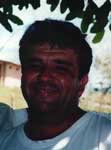 |
||
Leaving Max at Copan |
||
Although neither telephone nor the mail is reliable, we promise to exchange books, photos and follow up letters. Ironically, the most reliable communication link between us is e-mail, one of those wonderful contradictions that reveal deeper realities. Max, that is, communicates with us through a modern invention of the West that filters into (some would say, invades) his world. Simultaneously, his culture and heritage, once so distant and primitive to us, permeates our lives through the same questionable medium.
Entering Guatemala in the second week of our trip is something of a homecoming. Suddenly men, women, and children in native dress (not seen in Honduras) travel along the road; people the world has all but forgotten, and who we haven't seen in four years.
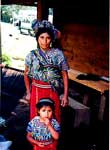 Like plumed birds outside the bus window, girls and women wear the traditional "huipiles" (pronounced wee-PEEL-es), intricately woven tops in bright red, green, yellow, and purple patterns that can identify the wearer's village, her standing, and her age.
Like plumed birds outside the bus window, girls and women wear the traditional "huipiles" (pronounced wee-PEEL-es), intricately woven tops in bright red, green, yellow, and purple patterns that can identify the wearer's village, her standing, and her age.A girl, barefoot, chases her goats and two oxen from our path; a man walks bent with his daily load of firewood on his back; a woman, leading several children and a dog, steadies a jug of water on her head, while the child beside her carries a basket of laundry on hers.
We no longer feel the strong presence of the West. Many Indian traditions that go back thousands of years are still part of every-day life, especially here in the mountains, away from the larger cities.
Continue with Part 5 of Discovering the Roots of Enchantment in Guatemala and Honduras
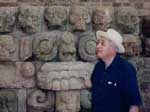
Book Reviews: The Sweet Waist of America
|
|
Harvy and carved writing, Copan
Top of Page
|
|||||||||||||||||||||
|
|||||||||||||||||||||